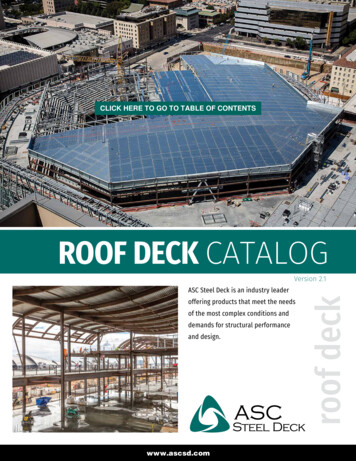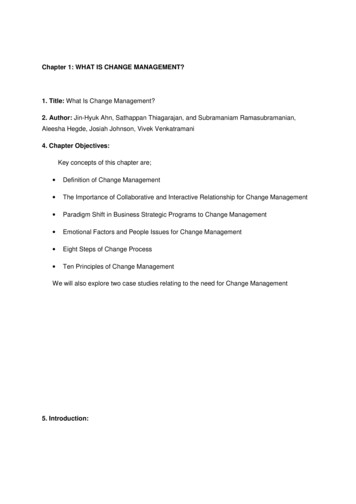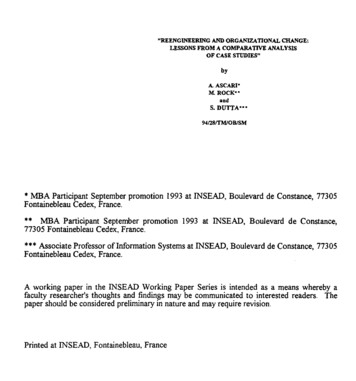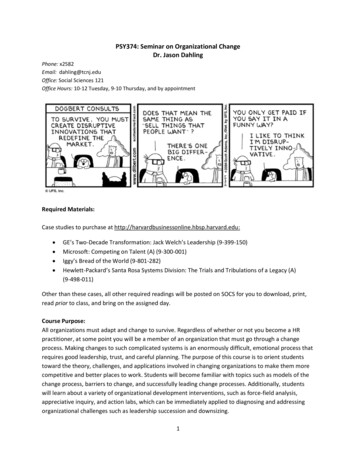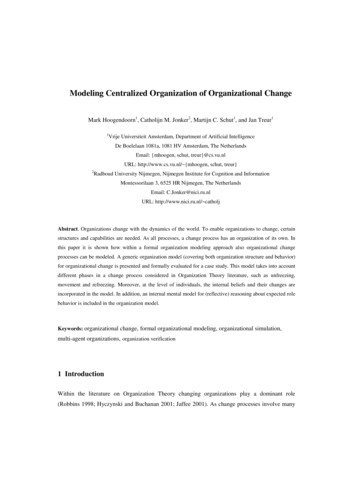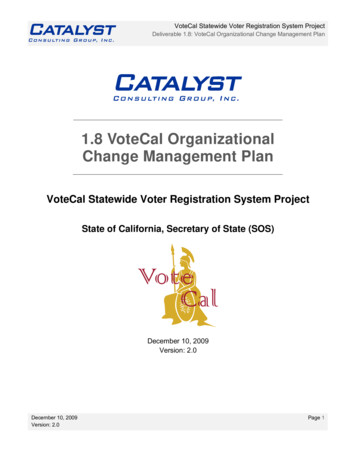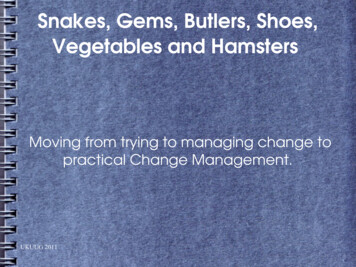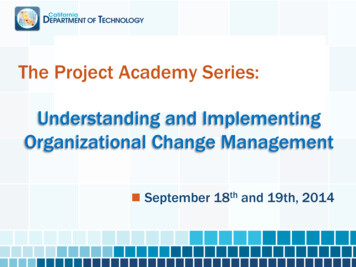
Transcription
The Project Academy Series:Understanding and ImplementingOrganizational Change ManagementSeptember 18th and 19th, 2014
Welcome and IntroductionsJacquelyn Moore:IT Project Manager, Project Delivery, CaltransJessica Chin:Section Manager, SAP Enterprise SystemsFunctional and Business Analysis, DWR2
AgendaObjectivesWhat is Organizational ChangeManagement (OCM)?The Human Factor at Organizational LevelWhere do you start?Fundamentals, Tools, and TemplatesWrap-UpQuestions3
ObjectivesWhat Is OCM?Why It Is ImportantThe Human FactorOrganizational Goals and ObjectivesRecognize the 5 Pillars of SuccessfulChangeUtilize OCM Tools and Templates4
Cross Your Arms5
Organizational Change ManagementWhat is it?Why is it important?Five Pillars of Successful Change6
Organizational Change ManagementOrganizational Change Management isan approach to transitioning anorganization including its people fromtheir current state to a new state.PeopleProcessCultureStrategyReadyforChange7
Organizational Change ManagementWhy is it important?Organization can drive better performanceand amp up business results through effectivechange management.Leading change is an important part of aleader’s job.Top 5 Organizational Change Challenges:1.2.3.4.5.Resistance from the people who need to changeNavigating the political landscapeAddressing team dysfunctionsDifficult conversation/coaching/feedback to senior leadersDealing with ambiguity, uncertainty, inability to forecast the future8
5 Pillars of Successful ChangeCommunicationSponsorshipStakeholder ManagementReadinessTraining and Turnover9
How Does OCM Fit Into YourBusiness Goals and Objectives?Bringing Strategy to Life 10
Cultural Alignment: Making It RealWhat defines an organization’s culture?Culture generally refers to the shared setof values, principles, assumptions, beliefs,symbols and behaviors that reflects howwork gets designed and executed. In short,it’s “how things are done around here.” Ofcourse, no two organizations’ cultures areexactly alike.11
What makes up a organization’scultural profile?In other words what makes anorganization successful?Efficiency, Quality, Innovation, CustomerService, Company Image12
13
Human Side of Change – PeopleBy creating Awareness you define the problem andcreate a common understanding.Understanding creates the Desire to fix the problem,establishing ownership.Ownership drives the Knowledge to find a solution.Owning solutions leads to Acceptance of change.Acceptance leads to SUCCESS!Success with the PEOPLE who influenced the Change!REINFORCE through awareness and training, even afteryour project has ended.14
OCM at Organizational Level15
Where Do You Start?16
Stages of Change17
Project Work Plan (OCM WBS)Templates\Sample OCM Project Schedule2007 Version.mpp18
Strategy:Aligning OCM Lifecycle with ProjectLifecycle1.2.3.4.5.PreparingManaging PlanningManaging ExecutionTransitionMonitoring19
Change Readiness AssessmentWhy is it important?What does it tell you?Best Practices20
Why Is It Important?Culture and value systemCapacity for changeMiddle management's predispositiontoward the changeEmployee readiness for change21
Change Readiness Assessment22
Exercise – 10 Minutes23
InstructionsThink of a change initiative your organizationneeds to implement.Take the assessment individually based on yourrole in your organization.There are 5 short questions for each of the fivePillars.Enter a response that best represents yourorganization’s ability to manage change.24
Things to think about when fillingout the assessment1.How well does your organization function during change efforts?2.How well positioned is the organization to be able to absorb all thechanges planned without creating significant risk of overload in affectedareas?3.What are the resources involved and what is their degree of skills andexperience?4.What is your leadership’s capability of sponsoring and supportingchange?5.What generates desire for the change and what creates resistance to it?6.What do you need to improve support and reduce roadblocks for thechange?7.What is your corporate culture and historical experience in dealing withchange?25
What does it tell you?Average score is calculated at each PillarRisks and potential obstaclesGaps in communication, training, sponsorship,and transition strategy required to implementchangeSpecial Tactics needed to support and sustainchange26
What do you do with the results?If your average score is below 4 for any of thecategories, this indicates the organization is notfully prepared and should spend efforts on thatpillar to improve readiness.Develop strategies to address areas that needimprovement.Select a change management team model andteam size.Select a sponsorship model and support system.Customize communication plans, training plans,coaching plans and sponsorship activities.27
Best PracticesChange management team or project leadersuse the assessment as a tool to assess theorganization's readiness to change.Independent vs. Third PartyAgile, flexibleUnbiased opinionInclude employee and manager interviews andsurveys. When collecting data from a largenumber of employees, focus groups can also beused in place of one-on-one interviews.28
Best Practices (Continue)Use it to plan your change management strategyand help the project team make informeddecisions to managing change.Use it as a planning aid and not as the bulk ofthe change management effort.29
Break – 15 Minutes30
OCM Fundamentals, Tools, andTemplatesOCM MethodologiesOCM StrategiesFive Pillars of Change31
Common ar-model/overview-3/32
Organizational Change Management33
Five Pillars for Successful r ManagementReadinessTraining34
CommunicationCommunications Strategy and PlanEstablish audience groupsTailor your messagingUse multiple delivery channelsBe visibleTemplates\OCM-Communications-Plan.doc35
Executive SponsorshipSponsors build commitmentHave Competing prioritiesDecision makersSponsor MeetingsEstablish Directives / PoliciesChampions the effortTemplates\OCM-Change-LeadershipReview.doc36
Stakeholder ManagementConduct Stakeholder Impact AnalysisActively engage your partners and committo a partnership.Understand the reason, need and benefitsof change.Address the concernsTemplates\OCM Stakeholder Map.docx37
ReadinessAssess your organization’s readinessbefore implementationPeople, Culture, Processes, StrategicAlignmentEstablish a Change TeamCelebrate success and early wins38
Training and TransitionEstablish a comprehensive training planTrain your leaders and change agents inOCMTraining Needs AssessmentIdentify roles and skill buildingrequirementsTransition PlanReinforce and encourage learning39
Wrap-UpBe ahead of Change, OCM starts at theBEGINNINGAssess your organization’s readiness forchangeIncorporate the Five Pillars of SuccessfulChangeUnderstand the human factor ofchange the people40
The Readiness GuidesProject Readiness Guideshttp://www.cio.ca.gov/opd/itla/itla21.html41
Questions42
Select a sponsorship model and support system. Customize communication plans, training plans, coaching plans and sponsorship activities. Best Practices 28 Change management team or project leaders use the assessment as a tool to assess the organization's readiness to change. Independent vs. Third Party Agile, flexible Unbiased opinion Include employee and manager interviews and surveys.

